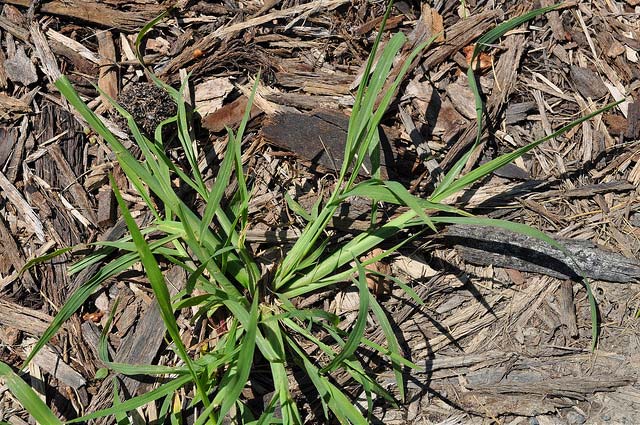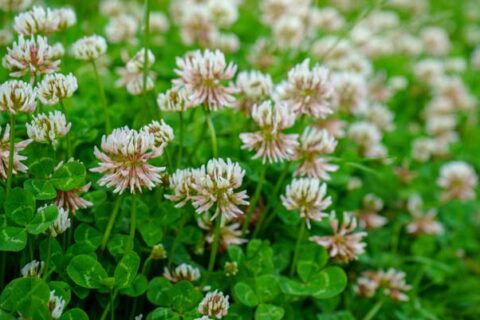Control crabgrass this spring and grow a beautiful lawn

Does your neighbor have a beautiful, lush, green lawn, but your property is filled with bare spots and crabgrass?
You’re not alone.
Crabgrass is an aggressive, summer annual weed that makes thousands – if not millions – of lawns look unsightly. The plant loves to grow in warm soil and in conditions that cool-season turf, such as Kentucky bluegrass, rye and fescue, struggle to develop in. Because of this, crabgrass can easily outcompete other grass species, making it difficult to control.
While many types of crabgrass exist, you can control all of them in basically the same way: Apply preventive herbicides at the appropriate time and adhere to proper cultural procedures, such as watering grass deeply but infrequently and mowing turf at the right height. The latter will help create a thick lawn, which is less condusive to being overwhelmed by crabgrass because the weed doesn’t have much area to become established. In a healthy lawn, crabgrass seedlings fight for nutrients and light as they struggle to grow beneath the turf’s opaque canopy, much like small trees struggle to grow in a dense forest.
However, even if a lawn is thick, it’s still important to apply a preventive crabgrass killer because a single, large crabgrass plant can produce upwards of 150,000 seeds. These seeds can travel great distances by wind, shoes and animals, and settle in weak spots, such sidewalk curbs where soil is hotter and more compact.
Crabgrass loves to grow in mid-summer and in exposed, thin areas of lawns. Thin areas can develop for a number of reasons:
- Mowing incorrectly
- Watering incorrectly
- Animal feces or urine – excessive nitrogen from animals or pets can thin out turf, making these areas more conducive to crabgrass growth
- Areas that are less conducive to turf growth – saturated soil
- Street and driveway edges where the soil is likely to heat up.
A crabgrass control strategy consists of the following:
- Focus on growing a thick, healthy lawn: Crabgrass control works best when it seeps at least a few inches into the soil. It must be watered in. A thin lawn will struggle to keep crabgrass control in place, especially when the soil is dry and compact like cement. A great way to thicken up your lawn is to adhere to a regular fertilizer program, providing your grass with nutrients over regularly spaced intervals.
- Mow regularly: We’ve heard some professionals suggest mowing turf short (scalping it) early in the spring to remove crabgrass seedlings. While this advice, on the surface, may seem sound, it has one major flaw: Crabgrass loves to grow in thin lawns, and mowing cool-season grasses below the recommended 3.5-4 inches can actually cause turf to thin over time. So, while it may seem like mowing crabgrass seedlings could be a short-term fix – if that – you’re actually creating a long-term problem. Instead, mow cool-season grass at the correct height.
- Water properly: Lawns need to soak up at least an inch of water a week, whether that’s from rainfall or sprinkler systems. Furthermore, that water must soak deep into the soil, which allows turf roots to grow well-below the surface. The closer roots are to the soil’s surface, the more prone the turf is too drying and thinning out. As this happens, crabgrass moves in and takes over. It’s also important to water in pre-emergent crabgrass control immediately after it’s applied to turf.
- Apply crabgrass control in the spring: GreenAce Lawn Care applies crabgrass control, or pre-emergent herbicides, on its first two applications of the year. We do this because pre-emergent crabgrass control can only kill crabgrass when it’s still developing. Under ideal conditions, the control creates a barrier between the crabgrass seedlings and the soil’s surface, halting them from germinating. However, if pre-emergent herbicides don’t succeed, you could try using a post-emergent herbicide, which can (but not always) kill crabgrass up to the third tiller. The tiller is the plant’s size. As crabgrass emerges from the soil, the weed grows from a 1-leaf plant to a 1-tiller plant, and then eventually to a very large, 5-tiller weed. By the time plants fully grow, the only way to kill them is to wait for the frost to arrive. We also don’t suggest yanking crabgrass from the ground. This only creates additional bare spots for other crabgrass plants to grow in.
- Aerate and seed in the fall: It’s assumed that the best time of year to control crabgrass is in the spring, but it’s really a year-round effort. Aerating in the fall can loosen your soil, allowing nutrients, water, and air to flow freely to turf roots. In turn, grass has an easier time growing and filling in thin areas, which otherwise would be taken over by crabgrass.
One of the most crucial aspects of home lawn care is controlling crabgrass. To do so, you’ll need a well-rounded, comprehensive long-term strategy (and a lot of patience) to reduce the aggressive weed. But once you do, you’ll instantly notice a difference, and you’ll be proud of the results.
We service many towns in Norfolk County, Mass. including Foxborough, Mansfield, Sharon, Walpole, Norwood, Westwood, Norfolk, Medway, Millis, Medfield, Dover, Sherborn, and surrounding towns. For more information, contact us today.
Your trusted lawn care provider and lawn pest exterminator
We Service Areas of Norfolk and Bristol County, Massachusetts Including, Foxborough, Mansfield, Wrentham, Walpole, Plainville, Franklin, Norfolk, Sharon, North Attleborough, and Parts of Attleboro, Stoughton, Canton, Norwood, Norton and Medfield. Learn more about our Complete Lawn Care program.


